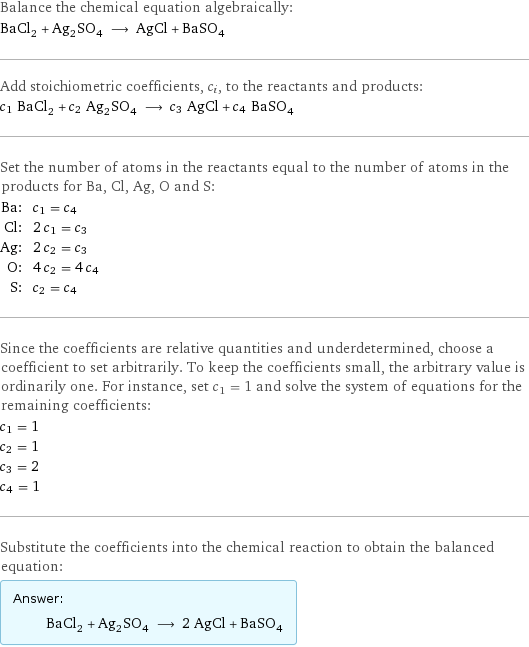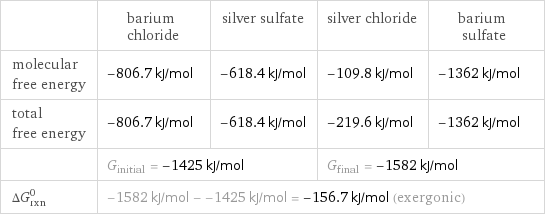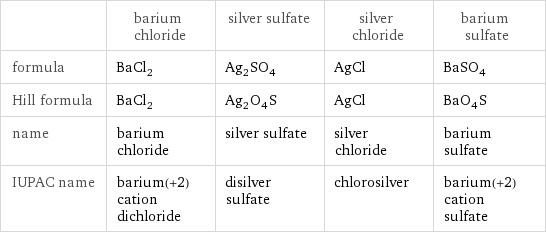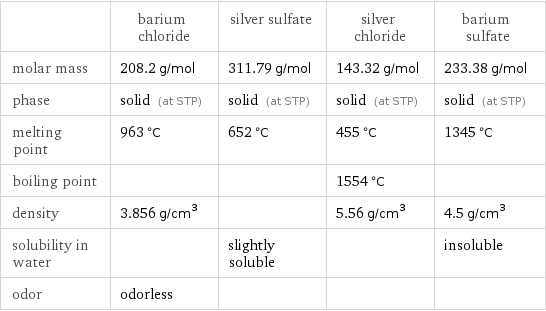Input interpretation

BaCl_2 barium chloride + Ag_2SO_4 silver sulfate ⟶ AgCl silver chloride + BaSO_4 barium sulfate
Balanced equation

Balance the chemical equation algebraically: BaCl_2 + Ag_2SO_4 ⟶ AgCl + BaSO_4 Add stoichiometric coefficients, c_i, to the reactants and products: c_1 BaCl_2 + c_2 Ag_2SO_4 ⟶ c_3 AgCl + c_4 BaSO_4 Set the number of atoms in the reactants equal to the number of atoms in the products for Ba, Cl, Ag, O and S: Ba: | c_1 = c_4 Cl: | 2 c_1 = c_3 Ag: | 2 c_2 = c_3 O: | 4 c_2 = 4 c_4 S: | c_2 = c_4 Since the coefficients are relative quantities and underdetermined, choose a coefficient to set arbitrarily. To keep the coefficients small, the arbitrary value is ordinarily one. For instance, set c_1 = 1 and solve the system of equations for the remaining coefficients: c_1 = 1 c_2 = 1 c_3 = 2 c_4 = 1 Substitute the coefficients into the chemical reaction to obtain the balanced equation: Answer: | | BaCl_2 + Ag_2SO_4 ⟶ 2 AgCl + BaSO_4
Structures

+ ⟶ +
Names

barium chloride + silver sulfate ⟶ silver chloride + barium sulfate
Reaction thermodynamics
Enthalpy

| barium chloride | silver sulfate | silver chloride | barium sulfate molecular enthalpy | -855 kJ/mol | -715.9 kJ/mol | -127 kJ/mol | -1473 kJ/mol total enthalpy | -855 kJ/mol | -715.9 kJ/mol | -254 kJ/mol | -1473 kJ/mol | H_initial = -1571 kJ/mol | | H_final = -1727 kJ/mol | ΔH_rxn^0 | -1727 kJ/mol - -1571 kJ/mol = -156.3 kJ/mol (exothermic) | | |
Gibbs free energy

| barium chloride | silver sulfate | silver chloride | barium sulfate molecular free energy | -806.7 kJ/mol | -618.4 kJ/mol | -109.8 kJ/mol | -1362 kJ/mol total free energy | -806.7 kJ/mol | -618.4 kJ/mol | -219.6 kJ/mol | -1362 kJ/mol | G_initial = -1425 kJ/mol | | G_final = -1582 kJ/mol | ΔG_rxn^0 | -1582 kJ/mol - -1425 kJ/mol = -156.7 kJ/mol (exergonic) | | |
Equilibrium constant
![Construct the equilibrium constant, K, expression for: BaCl_2 + Ag_2SO_4 ⟶ AgCl + BaSO_4 Plan: • Balance the chemical equation. • Determine the stoichiometric numbers. • Assemble the activity expression for each chemical species. • Use the activity expressions to build the equilibrium constant expression. Write the balanced chemical equation: BaCl_2 + Ag_2SO_4 ⟶ 2 AgCl + BaSO_4 Assign stoichiometric numbers, ν_i, using the stoichiometric coefficients, c_i, from the balanced chemical equation in the following manner: ν_i = -c_i for reactants and ν_i = c_i for products: chemical species | c_i | ν_i BaCl_2 | 1 | -1 Ag_2SO_4 | 1 | -1 AgCl | 2 | 2 BaSO_4 | 1 | 1 Assemble the activity expressions accounting for the state of matter and ν_i: chemical species | c_i | ν_i | activity expression BaCl_2 | 1 | -1 | ([BaCl2])^(-1) Ag_2SO_4 | 1 | -1 | ([Ag2SO4])^(-1) AgCl | 2 | 2 | ([AgCl])^2 BaSO_4 | 1 | 1 | [BaSO4] The equilibrium constant symbol in the concentration basis is: K_c Mulitply the activity expressions to arrive at the K_c expression: Answer: | | K_c = ([BaCl2])^(-1) ([Ag2SO4])^(-1) ([AgCl])^2 [BaSO4] = (([AgCl])^2 [BaSO4])/([BaCl2] [Ag2SO4])](../image_source/e262e62e0ce8206eedcc3e15c26e9f68.png)
Construct the equilibrium constant, K, expression for: BaCl_2 + Ag_2SO_4 ⟶ AgCl + BaSO_4 Plan: • Balance the chemical equation. • Determine the stoichiometric numbers. • Assemble the activity expression for each chemical species. • Use the activity expressions to build the equilibrium constant expression. Write the balanced chemical equation: BaCl_2 + Ag_2SO_4 ⟶ 2 AgCl + BaSO_4 Assign stoichiometric numbers, ν_i, using the stoichiometric coefficients, c_i, from the balanced chemical equation in the following manner: ν_i = -c_i for reactants and ν_i = c_i for products: chemical species | c_i | ν_i BaCl_2 | 1 | -1 Ag_2SO_4 | 1 | -1 AgCl | 2 | 2 BaSO_4 | 1 | 1 Assemble the activity expressions accounting for the state of matter and ν_i: chemical species | c_i | ν_i | activity expression BaCl_2 | 1 | -1 | ([BaCl2])^(-1) Ag_2SO_4 | 1 | -1 | ([Ag2SO4])^(-1) AgCl | 2 | 2 | ([AgCl])^2 BaSO_4 | 1 | 1 | [BaSO4] The equilibrium constant symbol in the concentration basis is: K_c Mulitply the activity expressions to arrive at the K_c expression: Answer: | | K_c = ([BaCl2])^(-1) ([Ag2SO4])^(-1) ([AgCl])^2 [BaSO4] = (([AgCl])^2 [BaSO4])/([BaCl2] [Ag2SO4])
Rate of reaction
![Construct the rate of reaction expression for: BaCl_2 + Ag_2SO_4 ⟶ AgCl + BaSO_4 Plan: • Balance the chemical equation. • Determine the stoichiometric numbers. • Assemble the rate term for each chemical species. • Write the rate of reaction expression. Write the balanced chemical equation: BaCl_2 + Ag_2SO_4 ⟶ 2 AgCl + BaSO_4 Assign stoichiometric numbers, ν_i, using the stoichiometric coefficients, c_i, from the balanced chemical equation in the following manner: ν_i = -c_i for reactants and ν_i = c_i for products: chemical species | c_i | ν_i BaCl_2 | 1 | -1 Ag_2SO_4 | 1 | -1 AgCl | 2 | 2 BaSO_4 | 1 | 1 The rate term for each chemical species, B_i, is 1/ν_i(Δ[B_i])/(Δt) where [B_i] is the amount concentration and t is time: chemical species | c_i | ν_i | rate term BaCl_2 | 1 | -1 | -(Δ[BaCl2])/(Δt) Ag_2SO_4 | 1 | -1 | -(Δ[Ag2SO4])/(Δt) AgCl | 2 | 2 | 1/2 (Δ[AgCl])/(Δt) BaSO_4 | 1 | 1 | (Δ[BaSO4])/(Δt) (for infinitesimal rate of change, replace Δ with d) Set the rate terms equal to each other to arrive at the rate expression: Answer: | | rate = -(Δ[BaCl2])/(Δt) = -(Δ[Ag2SO4])/(Δt) = 1/2 (Δ[AgCl])/(Δt) = (Δ[BaSO4])/(Δt) (assuming constant volume and no accumulation of intermediates or side products)](../image_source/85294e66ad6d94402841f4b35cacea3a.png)
Construct the rate of reaction expression for: BaCl_2 + Ag_2SO_4 ⟶ AgCl + BaSO_4 Plan: • Balance the chemical equation. • Determine the stoichiometric numbers. • Assemble the rate term for each chemical species. • Write the rate of reaction expression. Write the balanced chemical equation: BaCl_2 + Ag_2SO_4 ⟶ 2 AgCl + BaSO_4 Assign stoichiometric numbers, ν_i, using the stoichiometric coefficients, c_i, from the balanced chemical equation in the following manner: ν_i = -c_i for reactants and ν_i = c_i for products: chemical species | c_i | ν_i BaCl_2 | 1 | -1 Ag_2SO_4 | 1 | -1 AgCl | 2 | 2 BaSO_4 | 1 | 1 The rate term for each chemical species, B_i, is 1/ν_i(Δ[B_i])/(Δt) where [B_i] is the amount concentration and t is time: chemical species | c_i | ν_i | rate term BaCl_2 | 1 | -1 | -(Δ[BaCl2])/(Δt) Ag_2SO_4 | 1 | -1 | -(Δ[Ag2SO4])/(Δt) AgCl | 2 | 2 | 1/2 (Δ[AgCl])/(Δt) BaSO_4 | 1 | 1 | (Δ[BaSO4])/(Δt) (for infinitesimal rate of change, replace Δ with d) Set the rate terms equal to each other to arrive at the rate expression: Answer: | | rate = -(Δ[BaCl2])/(Δt) = -(Δ[Ag2SO4])/(Δt) = 1/2 (Δ[AgCl])/(Δt) = (Δ[BaSO4])/(Δt) (assuming constant volume and no accumulation of intermediates or side products)
Chemical names and formulas

| barium chloride | silver sulfate | silver chloride | barium sulfate formula | BaCl_2 | Ag_2SO_4 | AgCl | BaSO_4 Hill formula | BaCl_2 | Ag_2O_4S | AgCl | BaO_4S name | barium chloride | silver sulfate | silver chloride | barium sulfate IUPAC name | barium(+2) cation dichloride | disilver sulfate | chlorosilver | barium(+2) cation sulfate
Substance properties

| barium chloride | silver sulfate | silver chloride | barium sulfate molar mass | 208.2 g/mol | 311.79 g/mol | 143.32 g/mol | 233.38 g/mol phase | solid (at STP) | solid (at STP) | solid (at STP) | solid (at STP) melting point | 963 °C | 652 °C | 455 °C | 1345 °C boiling point | | | 1554 °C | density | 3.856 g/cm^3 | | 5.56 g/cm^3 | 4.5 g/cm^3 solubility in water | | slightly soluble | | insoluble odor | odorless | | |
Units
